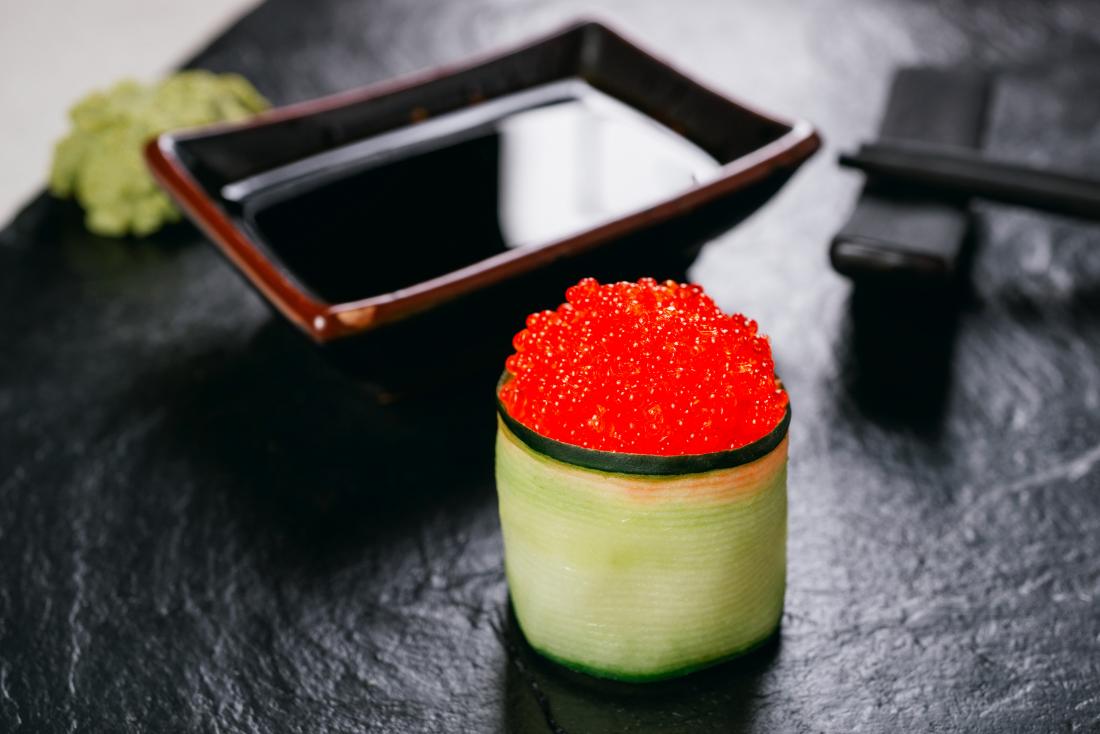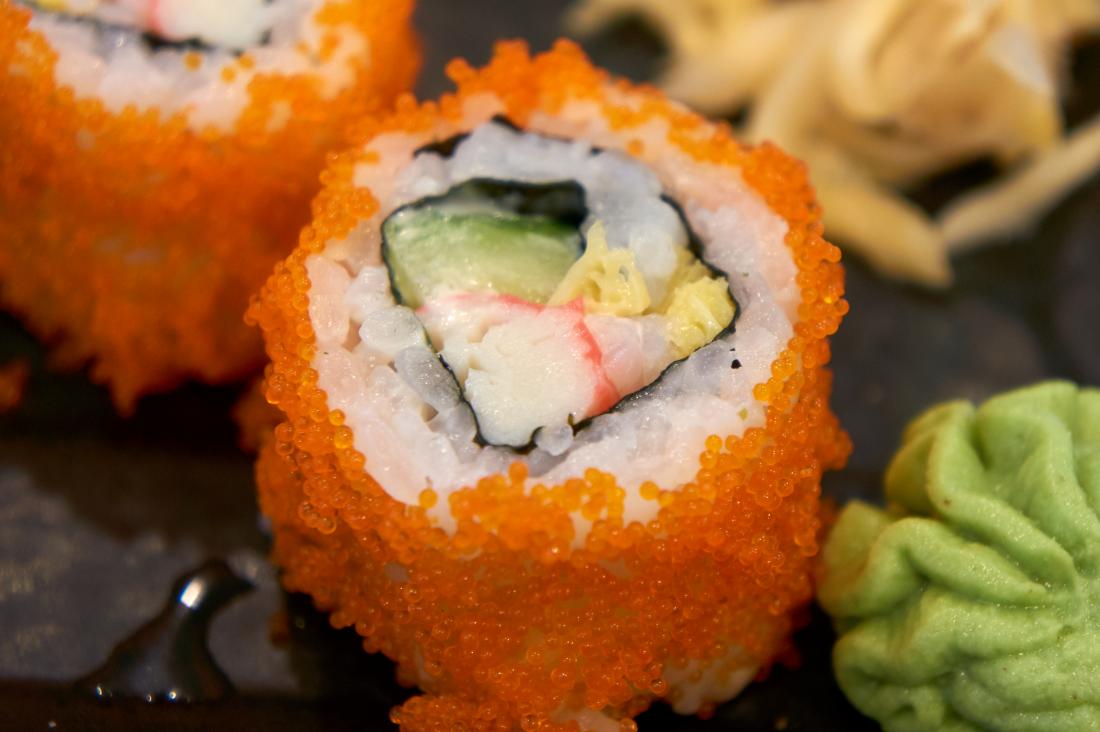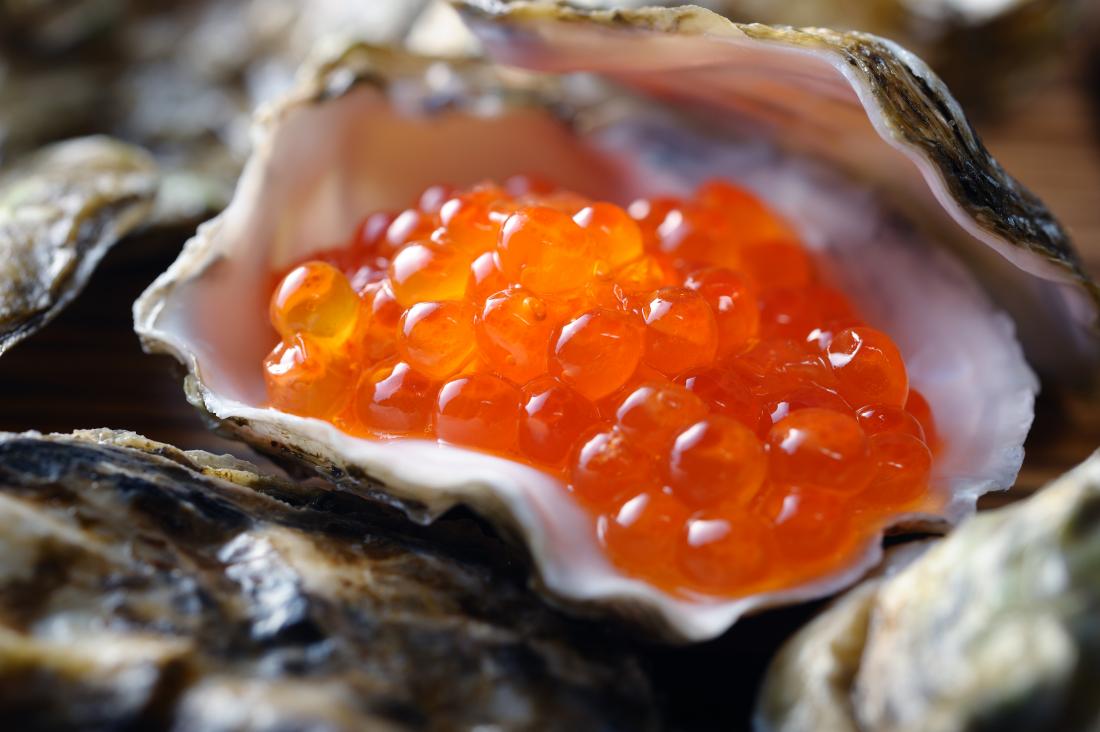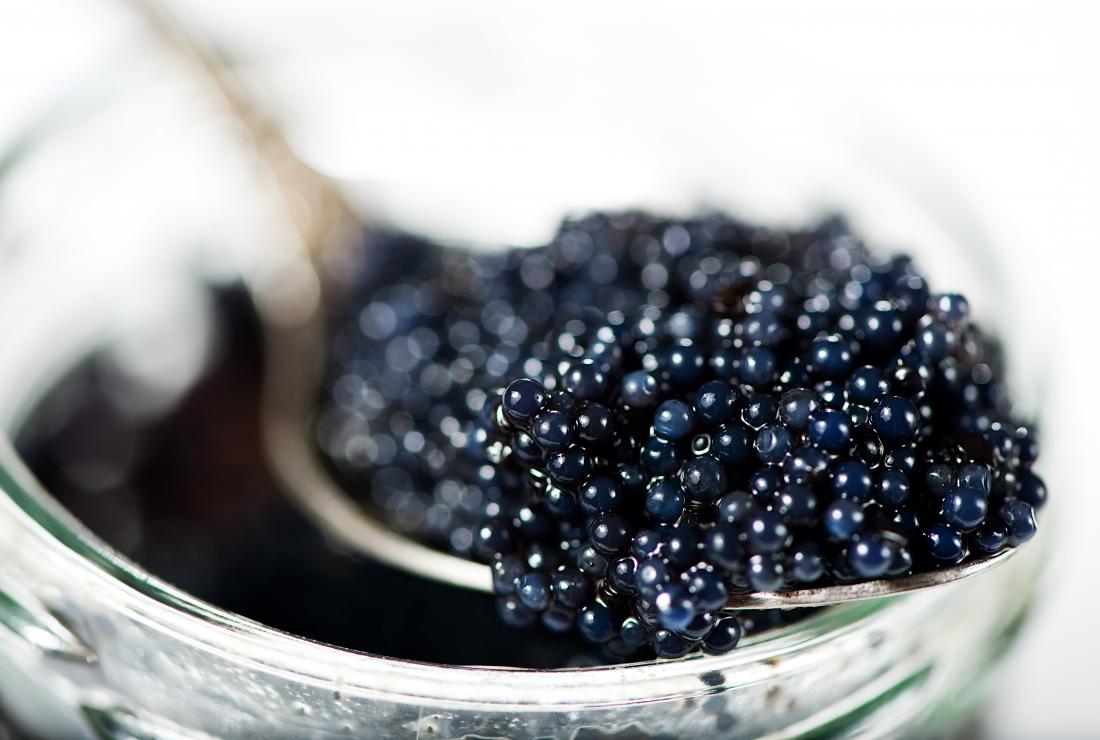Fish roe, in general, is a healthful food choice. As the United States Department of Agriculture note, fish roe is typically low in calories and rich in proteins and amino acids.
Roe contains numerous healthful minerals and nutrients, such as magnesium, selenium, and vitamin B-12, though these vary slightly among types.
Fish roe also contains healthful unsaturated fatty acids such as omega-3. These fatty acids may help reduce inflammation and protect the brain and other bodily systems from the effects of oxidative damage.
Also, a study that appears in the Journal of Food Science and Technology notes that roe is high in fats that can help improve learning ability and lower fat levels in the blood.
Each type of roe has distinct flavors and uses, though there are also many similarities between them.
Tobiko

It is common to see tobiko in sushi restaurants.
Tobiko is the name of the roe from the flying fish species.
The most common place to find tobiko is in sushi restaurants, where people sprinkle them on top of dishes or spread them on sushi rolls to give them a brighter look. People may also eat tobiko as a sushi or sashimi dish.
Tobiko usually has a naturally vibrant, bright reddish color, though restaurants sometimes add other natural ingredients, such as wasabi or squid ink, to alter its flavor and appearance.
Tobiko eggs are very small, typically under 1 millimeter in diameter. They have a characteristic crunch or bursting feeling when a person bites into them, and they add a distinct texture to food.
Tobiko is traditionally salt-cured and will typically have a smoky, salty taste. However, tobiko tends to be a little sweeter than other types of roe, such as caviar or ikura.
Similar to other types of roe, tobiko is high in proteins, omega-3 fatty acids, and other nutrients. In fact, a study in the International Journal of Molecular Sciences explains that flying fish roe, similar to salmon roe, is very high in phospholipid fats. These fats may help protect the heart and liver, reduce inflammation, and improve learning capacity.
However, tobiko is very high in cholesterol. That being said, this is not usually an issue in moderation, as the serving size for tobiko is typically very small.
Masago

Masago is similar in taste to tobiko.
Masago is the name of the roe from the capelin, which is a fish in the smelt family.
Masago may refer to roe from other types of smelt as well. These fish are small and produce very small eggs.
Masago has a bright reddish-orange look, though it is slightly less vibrant than tobiko. Some producers dye the eggs to pass them off as tobiko. However, the fish eggs themselves are much smaller, which gives masago a different texture.
Masago does not provide the same sensation as ikura or tobiko when a person eats it, as it is more sandy than crunchy.
Masago is also similar in taste to tobiko, though it tends to be more bitter. Similar to caviar, masago tends to be more of a garnish than the focus of a meal.
Due to their similarities, many restaurants use masago in place of tobiko, as masago tends to be much less expensive. Masago is common on sushi rolls and in other Japanese dishes but will likely not make up the bulk of a meal. It makes a good accompaniment for many rice dishes.
Masago itself is low in calories and delivers healthful proteins and fatty acids, plus important nutrients such as magnesium, selenium, and vitamin B-12, to the body. However, masago tends to be relatively high in sodium.
There are also some ethical concerns about eating masago. Capelin fish are important sources of food for many larger fish and marine animals, and overfishing may have a detrimental effect on the local environment.
Ikura

Ikura contains protein and vitamin A.
Ikura is the Japanese word for salmon roe. Salmon roe is much larger than many other types of roe.
Ikura also has an intense reddish-orange color due to specific pigment compounds in the egg. The eggs are shiny and should be slightly transparent.
Traditionally, farmers cured ikura in salt. Now, though, it is equally as common to find slightly sweet ikura or ikura marinated in a soy sauce base. Ikura should have a pleasant smell and a bold, rich flavor.
Ikura is a very nutritious food. As a study in the journal Clinical Interventions in Aging points out, ikura is high in healthful fatty acids, including:
- high-quality omega-3s in the form of eicosapentaenoic acid (EPA) and docosahexaenoic acid (DHA)
- omega-6
- omega-7
- omega-9
Ikura also contains good levels of protein and is high in vitamin A, a popular antioxidant. The pigment compound in ikura, called astaxanthin, is also a potent antioxidant, which may help fight damage from free radicals in the body and protect against signs of aging.
Caviar

People often use caviar as a garnish.
The word caviar, in the most classical sense, refers only to the roe of the wild sturgeon fish. This type of fish appears in the Caspian and Black sea.
Over time, caviar became synonymous with roe in general, but this is not technically accurate. Now, caviar refers to a few different kinds of fish but still typically refers to types of sturgeon.
Sturgeon caviar roe is small and glossy, about the size of a pea at most. Its color can range from amber or green to very deep black.
Caviar has a salty taste that many people say is similar to a sea breeze. The eggs have a crunchy texture and release a slightly sweet taste upon chewing.
There are many different types of sturgeon caviar, including:
- beluga
- kaluga
- osetra
- sevruga
- sterlet
- Siberian sturgeon
- white sturgeon
- hackleback
- paddlefish
For the most part, caviar is not an ingredient or dish but a garnish.
Sturgeon caviar has a beneficial nutritional profile, too. As a study in the International Food Research Journal notes, sturgeon caviar contains a high percentage of fats, including omega-3 fatty acids, specifically DHA and EPA.
Together, these two fatty acids can help reduce inflammation and support the proper function of the brain, heart, and eyes.
Caviar also contains an impressive amino acid profile, including:
- glutamic acid
- lysine
- leucine
- phenylalanine
Amino acids help build proteins in the body and play a role in muscular health and immune system function.
Caviar may bring to mind images of luxurious dinners or restaurants, and it is an exclusive food product. Particularly due to overfishing and contamination in the seas, true caviar prices are extremely high.
Summary
Tobiko, masago, ikura, and caviar are four different types of fish roe, or the eggs from fish. Each one comes from a different species of fish and carries slightly different characteristics and nutrients.
Roe, in general, is relatively beneficial for health, as it is low in calories and high in healthful fatty acids that support the body and reduce inflammation.
However, roe may be high in cholesterol or sodium. Prepared roe may be especially high in sodium and other potential added ingredients.
The differences among the types of roe begin in how people prepare and present them. Some types of roe, such as caviar and masago, are more of a garnish to a dish. Others, such as ikura and tobiko, may serve as the main ingredient in a dish.
In moderation, roe may be a healthful addition to many diets. It may help to try tobiko, masago, ikura, and caviar separately to determine personal preferences and find the best ways to present and enjoy them.
